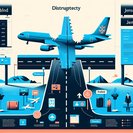
Irish low-cost carrier Ryanair announced on 16 November that quarterly pre-tax profit leapt to €1.96 billion—up 40 % on the same period last year—thanks largely to a boom in short-haul European traffic. The carrier’s load factor hit 96 % and average fares rose 7 % to €65, illustrating robust demand for intra-EU trips while trans-Atlantic travel lags.
Analysts point to travellers’ preference for ‘near-shoring’ holidays amid economic headwinds and lingering perception of U.S. entry hassles (ESTA scrutiny, longer immigration lines). Ryanair’s point-to-point network is ideally placed to capture that demand, reinforcing Ireland’s role as an aviation-services hub and keeping business-travel links across the continent fluid.
![Ryanair’s 40 % profit surge underscores Europe-centric travel shift]()
For corporate-mobility programmes, the figures suggest continued seat availability—and potentially higher prices—on core European routes used for short-term assignments in Ireland. HR teams budgeting 2026 travel should account for fare inflation and consider advance-purchase strategies, especially on Dublin-centric corridors to tech clusters in Spain, Portugal and Germany.
Ryanair CEO Michael O’Leary reiterated plans to increase capacity by 10 % next summer, pending delivery of additional Boeing 737-MAX-10 aircraft. The airline also confirmed ongoing discussions with Dublin Airport about raising the seat-capacity cap, a move that, if approved, could ease pressure on peak-time slots critical for commuting executives.
Beyond airfare, Ryanair’s results have wider policy relevance: the carrier’s success underscores the importance of seamless intra-EU mobility. Any future Irish moves to tighten border controls—even temporarily—could dampen connectivity and erode one of the key advantages that currently underpins Ireland’s attractiveness to multinational employers.
Analysts point to travellers’ preference for ‘near-shoring’ holidays amid economic headwinds and lingering perception of U.S. entry hassles (ESTA scrutiny, longer immigration lines). Ryanair’s point-to-point network is ideally placed to capture that demand, reinforcing Ireland’s role as an aviation-services hub and keeping business-travel links across the continent fluid.

For corporate-mobility programmes, the figures suggest continued seat availability—and potentially higher prices—on core European routes used for short-term assignments in Ireland. HR teams budgeting 2026 travel should account for fare inflation and consider advance-purchase strategies, especially on Dublin-centric corridors to tech clusters in Spain, Portugal and Germany.
Ryanair CEO Michael O’Leary reiterated plans to increase capacity by 10 % next summer, pending delivery of additional Boeing 737-MAX-10 aircraft. The airline also confirmed ongoing discussions with Dublin Airport about raising the seat-capacity cap, a move that, if approved, could ease pressure on peak-time slots critical for commuting executives.
Beyond airfare, Ryanair’s results have wider policy relevance: the carrier’s success underscores the importance of seamless intra-EU mobility. Any future Irish moves to tighten border controls—even temporarily—could dampen connectivity and erode one of the key advantages that currently underpins Ireland’s attractiveness to multinational employers.






